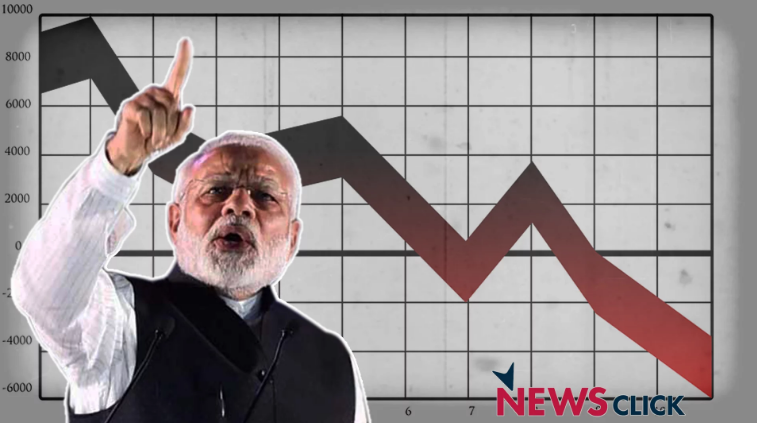Why Modi’s Popularity Graph and Economic Hardships Don’t Match

File Photo.
India is currently witnessing an unprecedented economic slowdown that some have even referred to as an economic emergency. It is marked by a contraction in growth in the core economic sectors, besides “weakening household and rural consumption”, growing inflation, unemployment and meagre FDI inflows.
Compared to the economic situation under the previous UPA regime led by the Congress party, today the economy is clearly faltering and this is having a palpable impact on the rural poor, the urban informal sector and the middle classes. However, again compared to the previous regime, there is no apparent disenchantment with the leadership of Prime Minster Narendra Modi. His popularity, according to recent surveys, is as high as 68%.
I distinctly remember that during the previous regime the rise in prices of onion had led to a series of street protests and inflation was registered in popular politics as “anti-people”. Much in contrast, inflation seems to be a non-issue today, even though people continue to suffer hardships. How does one explain such a contrast in such a short period of time? One could offer ready explanations about the media’s influence on the popular narrative, the impact of majoritarian religiosity, among others. However, these answers would not go beyond the surface level while what is happening indicates a shift in the very terms of discourse or the frames in which people seem to be thinking and comprehending social and political issues.
To make better sense of this moebius of a slowing economy and the growing popularity of the political leadership, I decided to do a brief ethnographic survey south of Vindhayas, where it is assumed that the hold of cultural nationalism, due to various historical reasons, is much weaker compared to the Gangetic belt. I felt it would give me a more reasonable or reasoned sense of the current developments. I visited a town and a village about 50 kilometres from the city of Hyderabad in Telangana. I also decided to spend more time with the more “informed” citizenry, who may be better aware of developments and their implications.
Over the course of a few days, I spoke to government-school teachers and local businessmen. These were free-wheeling discussions over cups of tea. I am recounting some of the startling ways in which issues are being framed to make sense of how teachers and businessmen still support, in fact admire, Modi’s leadership despite the conditions of economic hardship.
Teachers that I spoke to unequivocally supported the decisions that Modi has taken in the recent past. These include demonetisation, introduction of the GST, abrogation of Article 370, the resolve to build a temple in Ayodhya and the surgical strikes in Balakot. The most startling response was a teacher’s, who said, “Words are more important than work”. That the ability to communicate is inclusive and gives a glimpse into the intentions of the person, which are more reliable than making sense based on “mere” outcomes.
This remark of the teacher somewhat resonates with the recent slogan of the BJP—Saaf Niyat, Sahi Vikas—or Clean Intentions, Correct Development. However, a nagging doubt still persists whether the current populist regimes “constructs” or “manufactures” consent or “represents” a public morality that is organic.
Reality is always mediated through symbols, but how it gets structured at any given point of time depends on a web of variables that are both tangible/material and intangible/cultural/discursive. (Needless to say, they hold mutual influence beyond binaries.)
Temporal and spatial imaginations have been robustly politicised under the current regime. Modi has invited “people” to evaluate him vis-a-vis the “70 years they gave to the Congress party”. Morality of being reasonable in one’s assessment demands that much of Modi’s success is achieved in a very short time and his failures require more time to fructify into a favourable reality.
As many teachers said during the survey: “He acted and ‘resolved’ long-pending issues such as Kashmir and Ayodhya”, which the Congress had been procrastinating on. In the same breath they said that demonetisation failed to clean up corruption and GST adversely impacted the economy, but “one needs patience for results to come”. They found confidence or solace in the fact that “the world is already recognising India” and Modi has represented India well by speaking in Hindi and greeting with a “namaste” and not a handshake.
Such views give the impression that we make sense of reality not in frames but in everyday practices whose meaning we are relatively surer about.
Equally revealing were my discussions with the local business community whose members had, by and large, suffered on account of the economic slowdown. In fact, those helping me with local contacts and accompanying me were pretty sure that I would get a contrasting picture from them. But much to their shock and my surprise we found in them a wholesome endorsement of Modi’s leadership, even as all, without exception, agreed that they suffered losses in the recent few months.
When asked if demonetisation and GST caused these losses they said, “Only those who are guilty complain.” In many important ways, demonetisation shifted the gaze inward and offered a different moral frame of evaluation. In that sense it was not a merely economic measure.
Similarly, on GST, one owner of a local medical store said, “I am honest and so it does not impact me”, and that the new system of taxation was introduced for the collective good.
Guilt and collective solidarity, self-discipline and protest had already changed positions. When I insisted to know how this idea of collective good can justify losses, the medical store owner replied that loss is relative. He also said that his losses were also on account of other reasons, including “my own inability” to cope with technological changes. Those who learned how to use a computer and operate online are doing much better, he said.
The idea of coping with a new reality assumes that there are things one is not sure how to understand. It could be technological changes or it could be a “new” kind of geopolitics that Modi is pursuing on a global scale. One can only relate to these changes through everyday practices, and in a situation where even that is not possible, one can either follow or express incapability.
Let me conclude by narrating what another small-time businessman told me about the airstrikes that took place in February 2019. He said, “Even assuming the strikes were false and never took place, they still prove what India is capable of.”
Hence what is happening is more than “invention of tradition” and perhaps a little less than madness. What it certainly signifies is the distinction people are making between being “merely” authoritarian and being authoritative, and this difference is what allows “people” to imagine themselves as more authentic beings.
(The survey was funded by DSA, CPS, JNU.)
The author is associate professor, Centre for Political Studies, JNU. His edited volume, Secular Sectarianism: Limits of Subaltern Politics, was published recently. The views are personal.
Get the latest reports & analysis with people's perspective on Protests, movements & deep analytical videos, discussions of the current affairs in your Telegram app. Subscribe to NewsClick's Telegram channel & get Real-Time updates on stories, as they get published on our website.
























